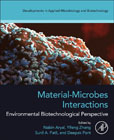
Material-Microbes Interactions: Environmental Biotechnological Perspective
Aryal, Nabin
Zhang, Yifeng
Patil, Sunil A.
Pant, Deepak
Interaction of microbes with biological or abiotic surfaces leads to the development of a matrix of cells living in close association and complex cooperation with each other, known as biofilm. Understanding the fundamental processes of biofilm formation, the role of material to exchange the energy with microbes, biofilm matrix, and optimization of biofilm formation process are useful to everyone involved with bioprocess development. Interestingly, academic institutions, wastewater treatment plants, and research centers have upscaled biofilm-based environmental technologies, such as moving bed bioreactors, microalgae, tricking bed reactors, biofilters, and bioelectrochemical process as promising environmental technologies. Nevertheless, access to the specific information on microbe-material interaction in biotechnology is still limited. Material-Microbes Interactions: Environmental Biotechnological Perspective brings great insights into microbes-material interactions, biofilm formation, and emerging bioprocess within the field of applied biotechnology. It systematically summarizes the fundamental principles, state-of-the-art in microbes-material interaction, and its application in bioprocess and environmental technology development. It will be of significant interest to the environmental technology developers, researchers, university professors, policymakers, graduate and postgraduate students and other stakeholders. Illustrates the growing interest in biofilm-based technology development, either wastewater treatment using carrier materials or valorizing waste material into resources using biofilm-based bioprocess Focuses explicitly on the microbes-material interactions in various biotechnologies Has a high degree of novelty by covering a broad range of biofilm-based bioprocesses, state-of-the-art and the trends within the field Includes photo-sets on biofilm development and bioreactor systems INDICE: Fundamentals and Advances 1. Microbial biofilm: formation, characteristics, and significance in the environment 2. Materials and their characteristics relevant to biofilm growth 3. Development of biocompatible materials for microbial-biofilm-based applications 4. Microbe-electrode interactions in bioelectrochemical systems 5. Understanding the electron transfer between electrode material for biosynthesis 6. Microbial biocorrosion phenomenon and electron exchange mechanism Specific application 7. Role of electrode engineering in a microbial fuel cell for bioelectricity production 8. Microbes-mineral interaction in bioremediation of toxic chemicals 9. Role of carrier materials in moving bed bioreactor for wastewater treatment 10. Microbes-material interactions for direct inter-species electron transfer in anaerobic digestion 11. Microbial-clay minerals interaction and biotechnological implications 12. Understanding of Individual-based modeling of biofilms of Heterogeneous Biofilms 13. Spatial surface modification of cathode material in microbial electrosynthesis of chemicals from carbon dioxide 14. Different carrier material application to develop biofilm in trickling bed based reactor for biogas upgrading 15. Material-microbe interaction for solar power driven biochemical synthesis 16. Methanogens-electrode interaction for methane production from carbon dioxide 17. Biofilters, bioscrubbers and biotrickling filters for the clean up contaminated air 18. iocorrosion control processes and mechanisms Sustainability aspect 19. Techno-economic implication and life cycle assessment of a bioelectrochemical processes for chemical and fuel synthesis 20. Techno-economic assessment of biofilm-based moving bed bioreactor for wastewater treatment
- ISBN: 978-0-323-95124-1
- Editorial: Academic Press
- Encuadernacion: Rústica
- Páginas: 420
- Fecha Publicación: 01/04/2023
- Nº Volúmenes: 1
- Idioma: Inglés
